The new BMW M 1000 R packs a powerful punch that’s about as exciting as it gets on a racetrack but as docile as you want on the road
Punting around the deliciously twisty roads of southern Spain on the potent new BMW M 1000 R has me thinking about a bike I fell head-over-heels for around 10 years ago. Back then AMCN had an Aprilia Tuono V4 Factory in its long-term test fleet and, like many others, I thought it was just about the perfect roadbike for someone who wanted one bike to ride on the road and the track. It offered the performance of a superbike combined with real-world practicality; it was comfortable, it was fast, it was loaded with the best electronic traction aids of the time and it sounded oh-so tasty.
Sure, with its high-revving inline four, the M 1000 R sounds nothing like an Italian V4, but it is a bike that like the Tuono nails its design brief to near perfection – these could be the ultimate roadbikes of their respective times.
A quick glance at the raw figures goes some way to explaining what makes the M 1000 R so good. Based on the existing S 1000 R nakedbike platform, the M 1000 R runs the same 999cc engine used in BMW’s S 1000 RR superbike… and it’s a ripper of a thing, punching out claimed peak outputs of 154kW (210hp) at a heady 13,750rpm and 113Nm of torque at 11,100rpm.

That’s 33kW more than the 121kW (164hp) S 1000 R. And while I’m sure many would argue that 121kW is more than enough power for the road, this is an M model… and BMW wants to make it clear to all that the M brand is synonymous with high performance in the motorcycling world (see sidebar, ‘The Power of M’), as it has already done in the car world, so a sub-200hp engine simply wasn’t going to cut it when this bike would be taking on 200hp+ hyper-naked rivals like the Ducati Streetfighter V4 and MV Agusta Brutale 1000.

The M 1000 R’s potent inline four is wrapped in a lightweight package that tips the scales at just 199kg wet. Semi-active suspension is automatically adjusted through selectable ride modes making the M 1000 R suited to a variety of conditions, from bumpy secondary backroads to billiard-table smooth racetracks, while a MotoGP-inspired aero package with big wings either side of the front side panels is designed to keep the front wheel on the deck under hard acceleration. And with all that power on tap, and lower overall gearing than the S 1000 R thanks to two more teeth on the rear sprocket (47 instead of 45), those wings really are a necessity rather than just a styling exercise.
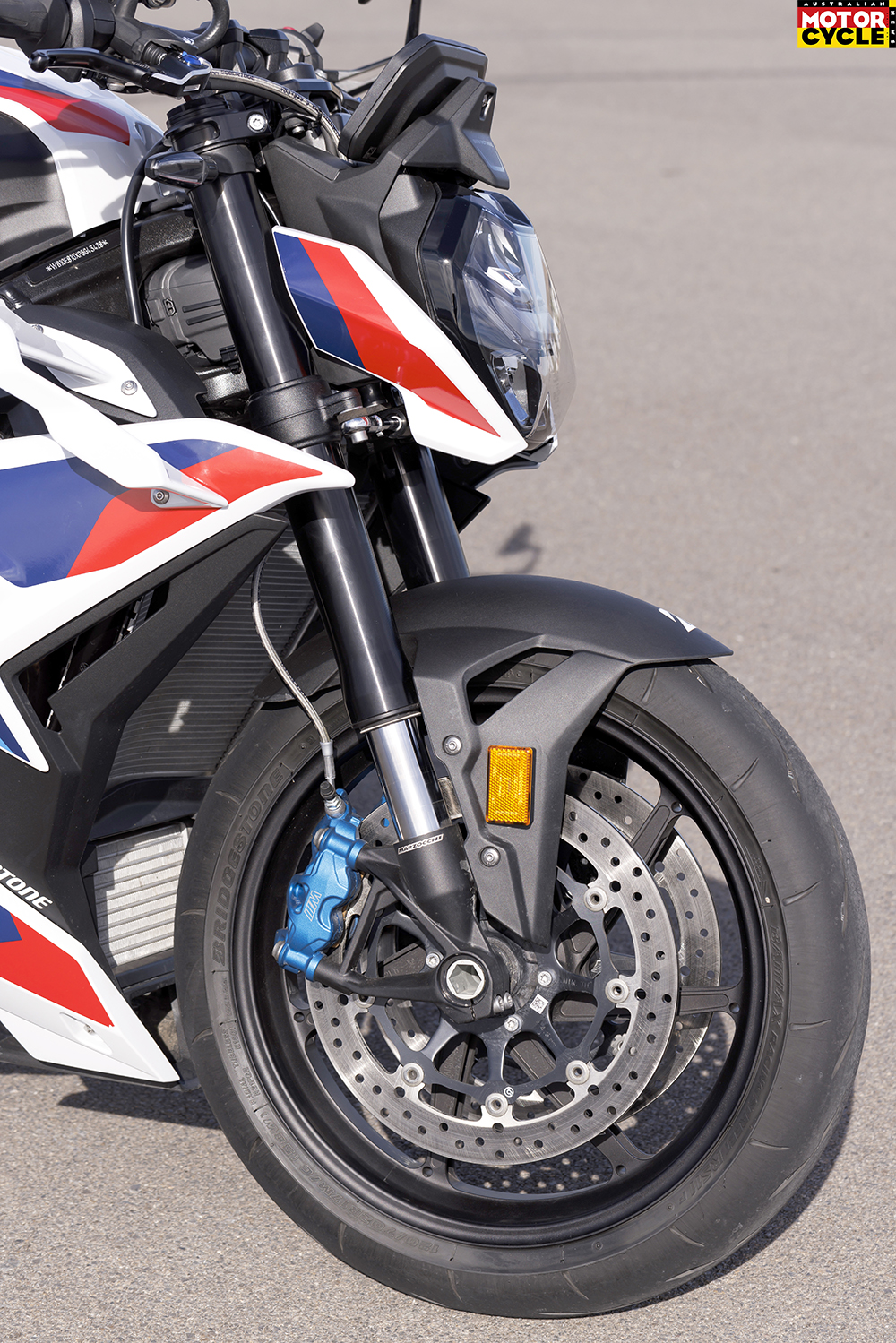
Unsurprisingly, the M 1000 R is packed with electronic traction aids, including the obligatory dynamic traction control and wheelie control systems, as well as adjustable engine-brake control and slide control, so despite its mammoth peak power output, it is actually a much easier bike to ride on the road than you would expect, no matter whether you just want to poke around for a leisurely weekend cruise or ride as hard as you’re willing to risk your licence.
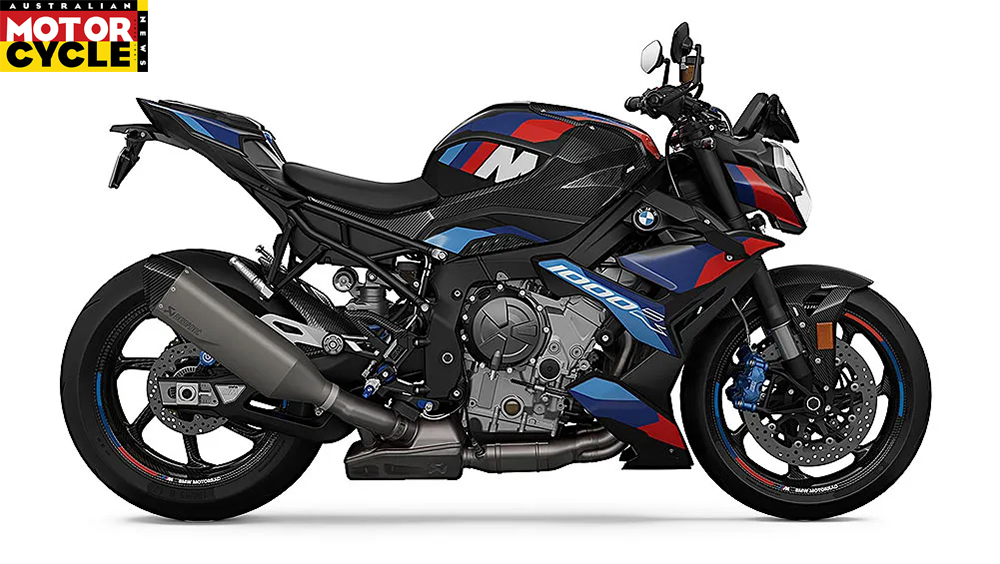
Thanks in part to BMW’s ShiftCam technology – variable valve timing and differential valve lift to optimise cam timing and duration dependent upon throttle opening and engine revs – the engine is user-friendly in normal road conditions with a broad and accessible spread of torque throughout the midrange, yet it offers a screaming top-end all the way to the 14,600rpm redline that transforms it into a trackday weapon.
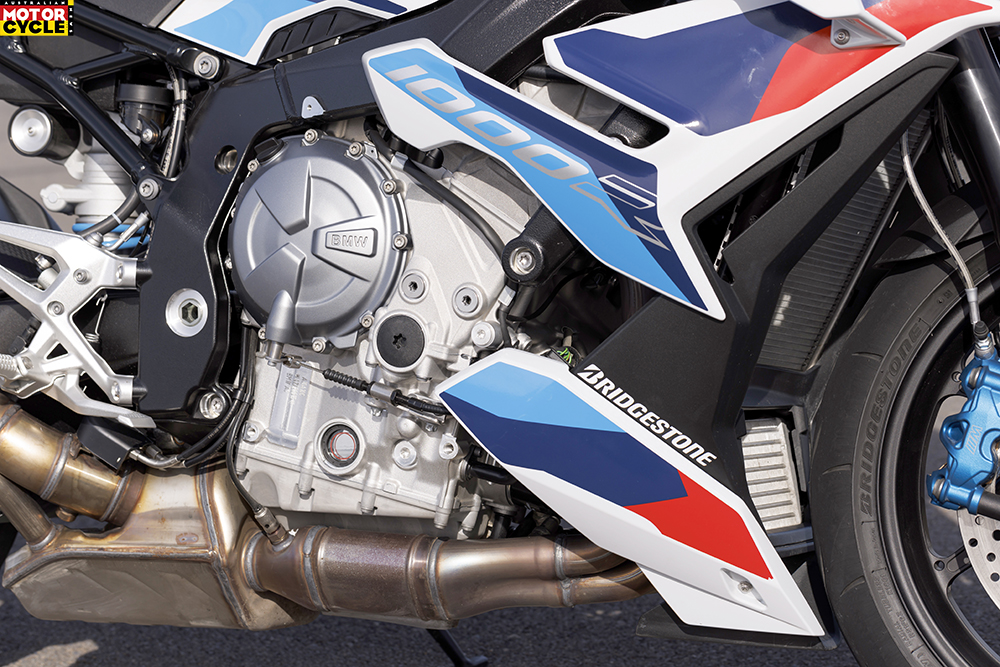
As well as the tractable nature of the engine, selectable ride modes aid in keeping all that available power in check. Those modes include Rain, Road, Dynamic, Race and Race Pro 1-3, the latter offering three tailorable race modes for those who want to set up their M 1000 R exactly as they like it, no matter the track or the conditions.
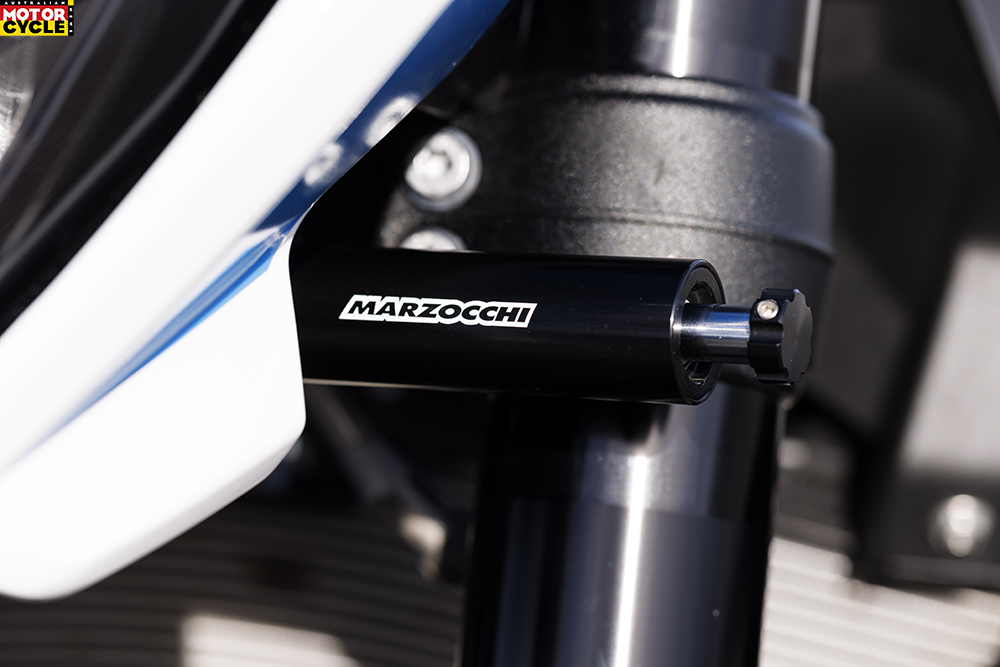
In addition to adjusting power output, power delivery and the level of electronic intervention, the selectable ride modes also adjust suspension damping through Dynamic Damping Control (DDC). For example, there is a faster throttle response in Dynamic than Road, the electronic intervention is lessened, and a firmer damping setting is applied. It’s easy to flick between ride modes on the fly, too, simply by pressing the mode button and closing the throttle or engaging the clutch momentarily.
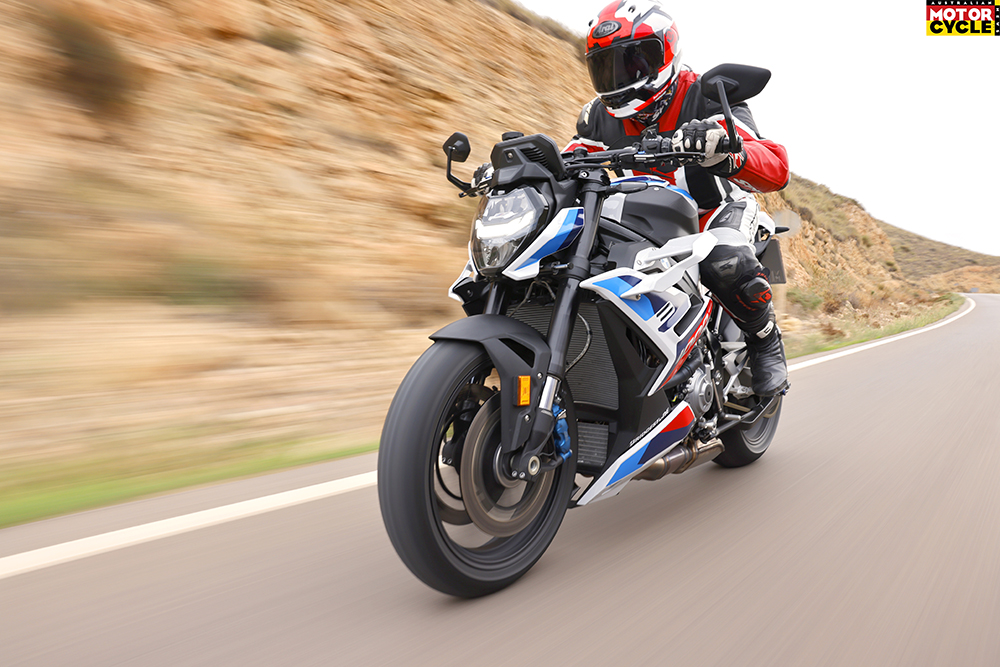
I flicked between Road and Dynamic on the smooth and flowing roads of our test loop; while Road still provides loads of performance, Dynamic does so with more aggression, but not to the point that it feels like a light switch. On the flipside, Rain mode limits power and subdues throttle response significantly, as well as ups the electronic intervention for slippery conditions.
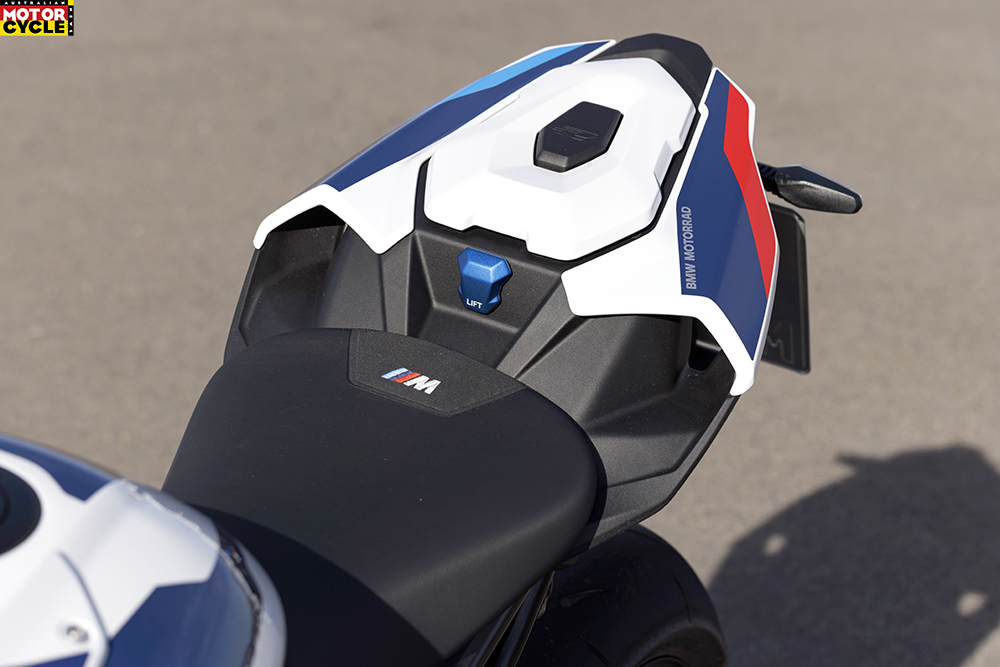
The M 1000 R runs a Marzocchi 45mm USD fork and a monshock rear with DDC. The suspension feels quite firm but in Road mode it does an admirable job on rough roads. Even in Dynamic it doesn’t feel too harsh for my 78kg weight, and it was never thrown off-line, even when confronted with big road surface irregularities.
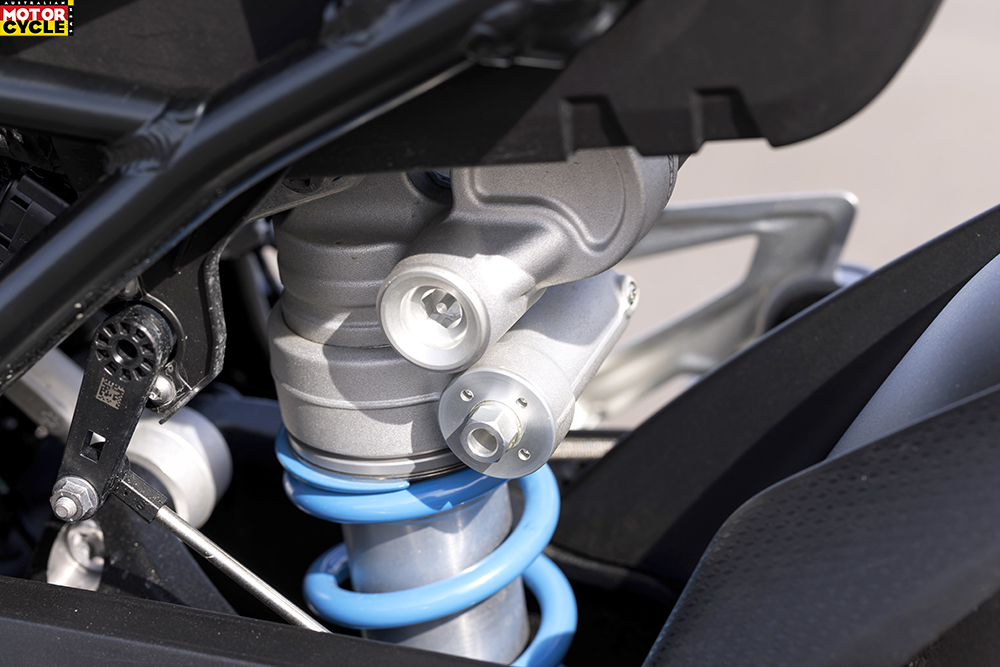
Race mode really is best left for the track, as it ramps up throttle response and firms up the damping significantly. In Race Pro 1-3 you can tailor all the settings and then save them, and the BMW Motorrad team had done this for us prior to our one session on the M 1000 R at the technically challenging Almeria circuit. Those settings include the DTC, the wheelie control, the Engine Brake and Brake Slide Assist.
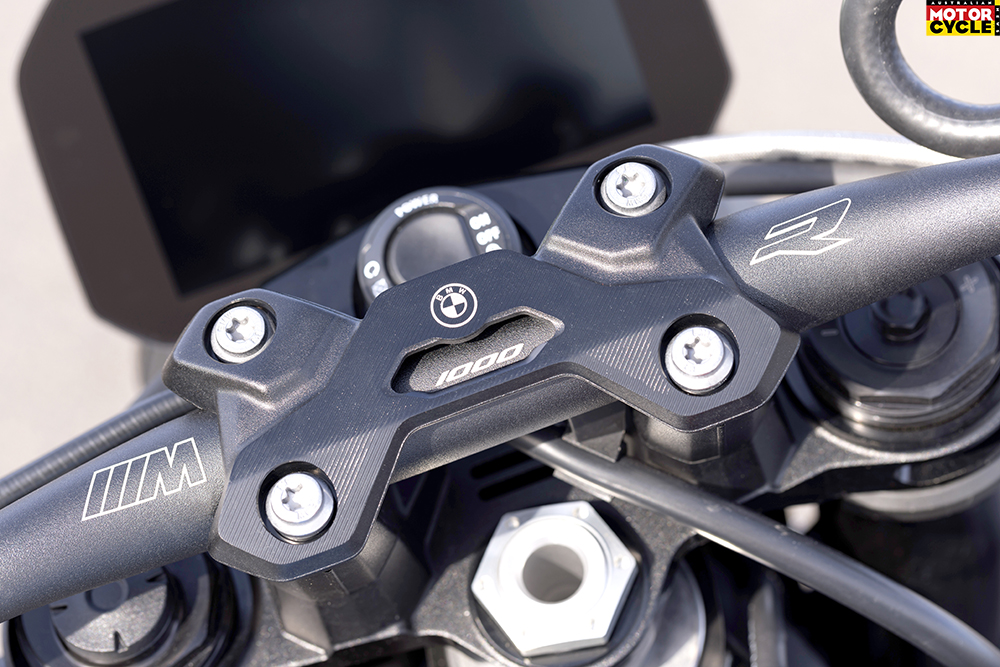
The Engine Brake features triple adjustability of the engine drag torque, and the Brake Slide Assist lets you lock up the rear and drift into corners like Garry McCoy, all without fear of crashing. If you dive into a corner too fast, back off the throttle completely and there’s enough engine braking to tighten the M 1000 R’s line so you don’t run wide. I did this a couple of times on some of Almeria’s trickier corners and still made the apex when I thought I had completely stuffed up. As for the effectiveness of the Brake Slide Assist, I’ll have to leave that up to more talented (read: ballsier) riders than I, suffice to say it is engaged automatically when braking hard into a corner using the front brake and then applying full brake pressure to the rear brake, allowing you to get the bike sideways heading into the corner, but not too much.
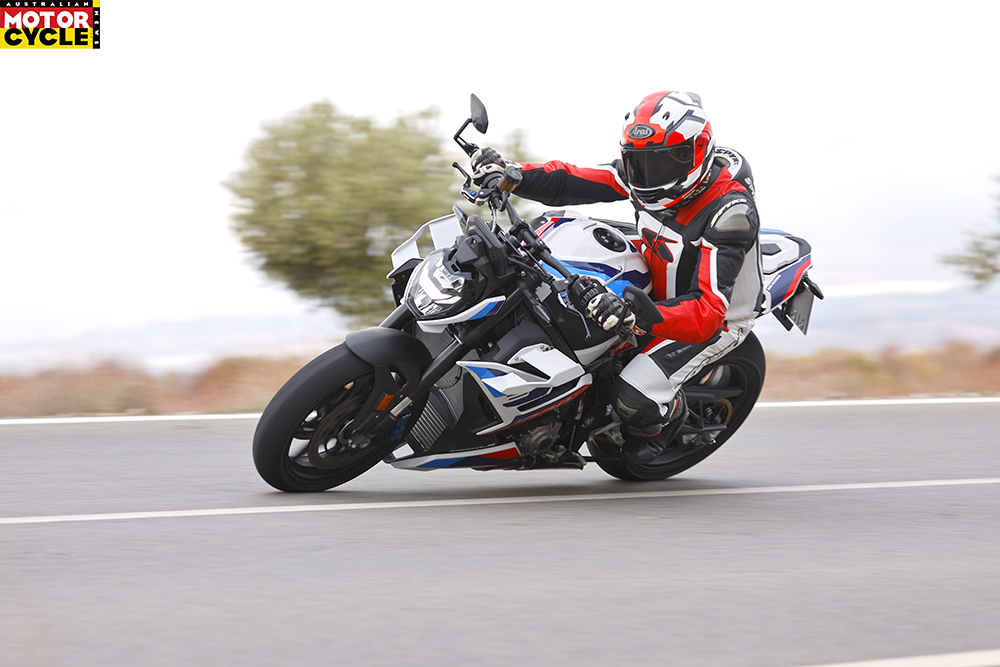
Steering is incredibly responsive and flicking the M 1000 R from side to side requires minimal effort thanks in part to its low overall weight, its lightweight forged aluminium wheels and its wide and high handlebar. In fact, so wide is the ’bar that it wouldn’t feel out of place on a dirtbike. It’s significantly wider and higher than the unit fitted to the S 1000 R, but the ’bar riser is reversible for those who want to lower it and roll it back a little for a more relaxed feel.
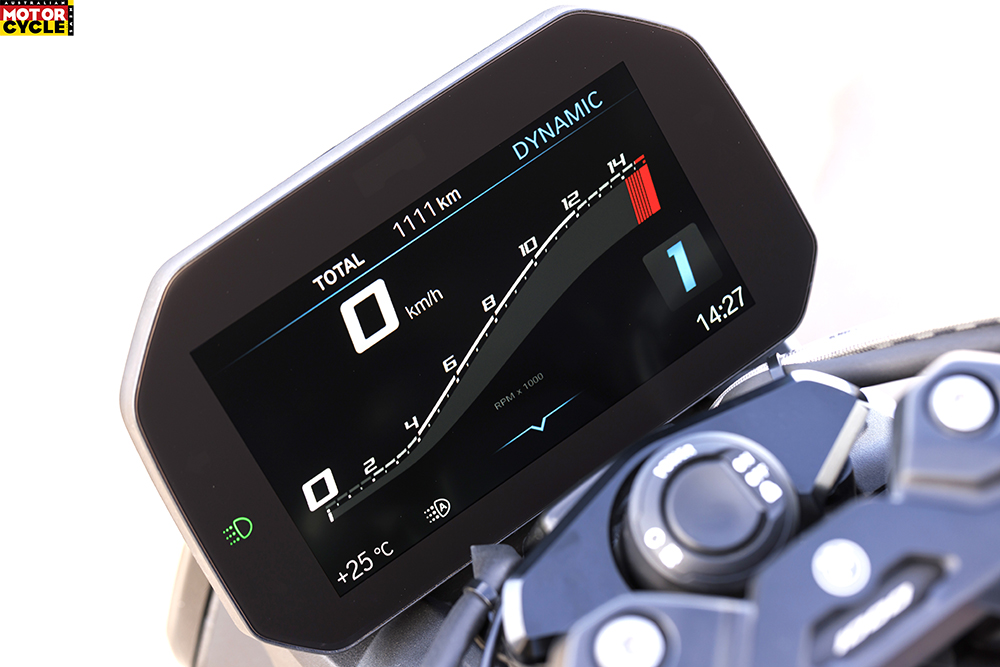
Despite the high ’bar, the riding position is still quite racy, with high footpegs that encourage you into a forward-leaning posture when you want to ride the M 1000 R fast. And there’s enough space to get your racing crouch on, but at higher speeds hanging on to that wide handlebar can become a chore as your upper body fights the windblast and assumes the pose of someone going in for a big hug at a family get-together.
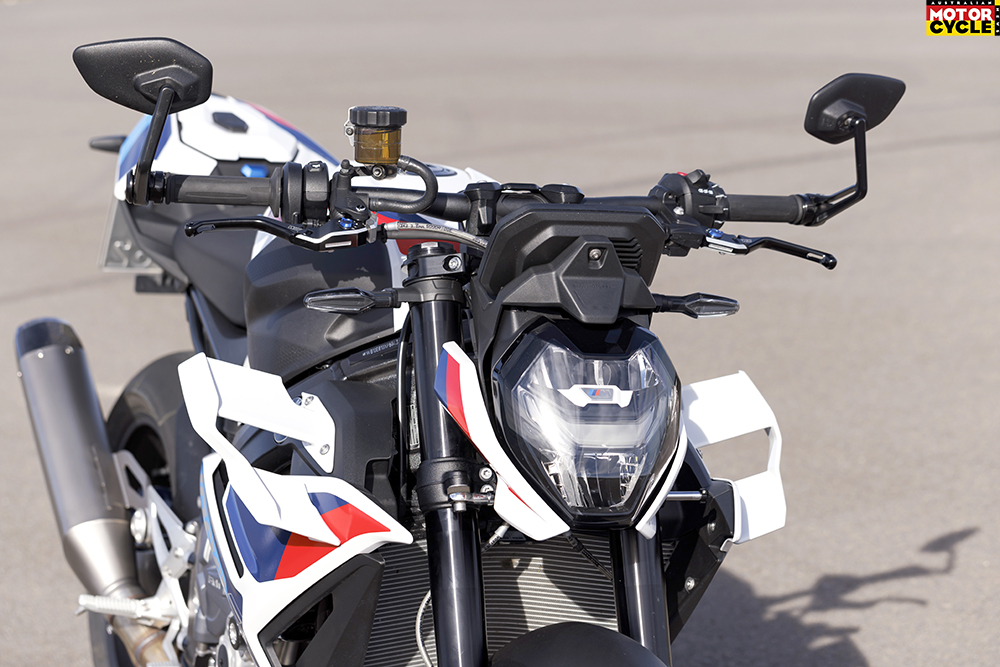
The sticky Bridgestone Battlax Racing Street RS11 rubber offers good feel and grip on the road. Feeling at home on the M 1000 R takes no time at all and you’ll soon find yourself throwing it into corners with complete confidence in the front-end, and once you get your head around how good the electronics are you’ll have no problem cracking the throttle wide open when exiting corners… earlier and earlier the more you get a feel for it. For the record, there’s easy access to the adjustable steering damper for those who want to add or remove a bit of damping to suit different scenarios.
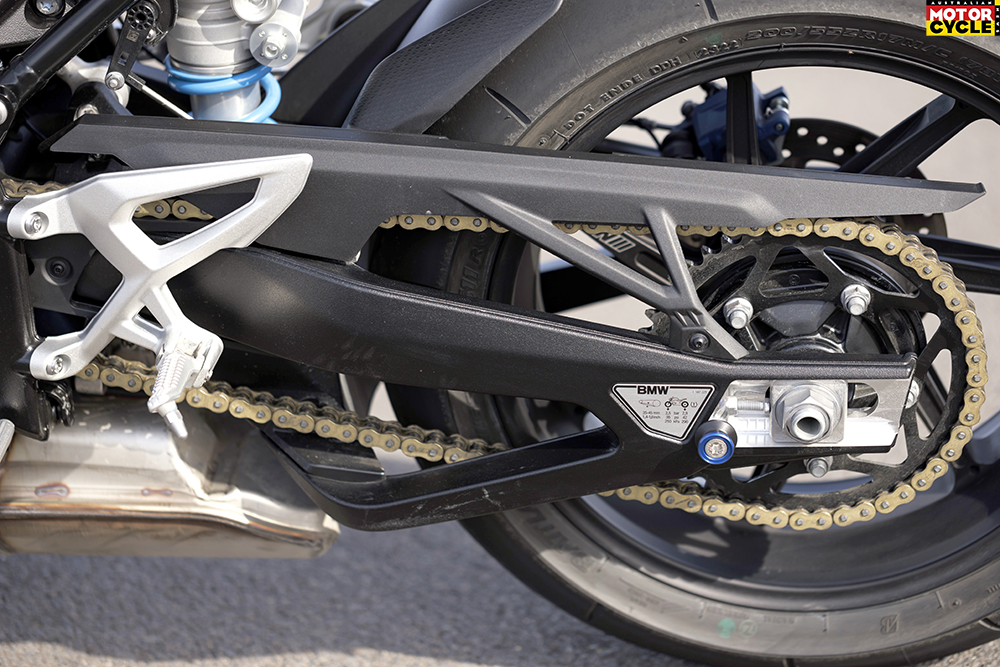
As you’d expect of a bike with 210hp and relatively low gearing, acceleration is phenomenal, the tacho racing to the redline through the gears and the M 1000 R forcing you back into the bump-stop when you crack the throttle wide open. BMW claims a 0-200km/h time of just 7.2 seconds, and while I didn’t find the time to test this, I have no reason to doubt it – this thing hammers! And you really can access all that power thanks to the electronics and the wings, which combine to do an absolutely fantastic job of keeping the front wheel on the ground.
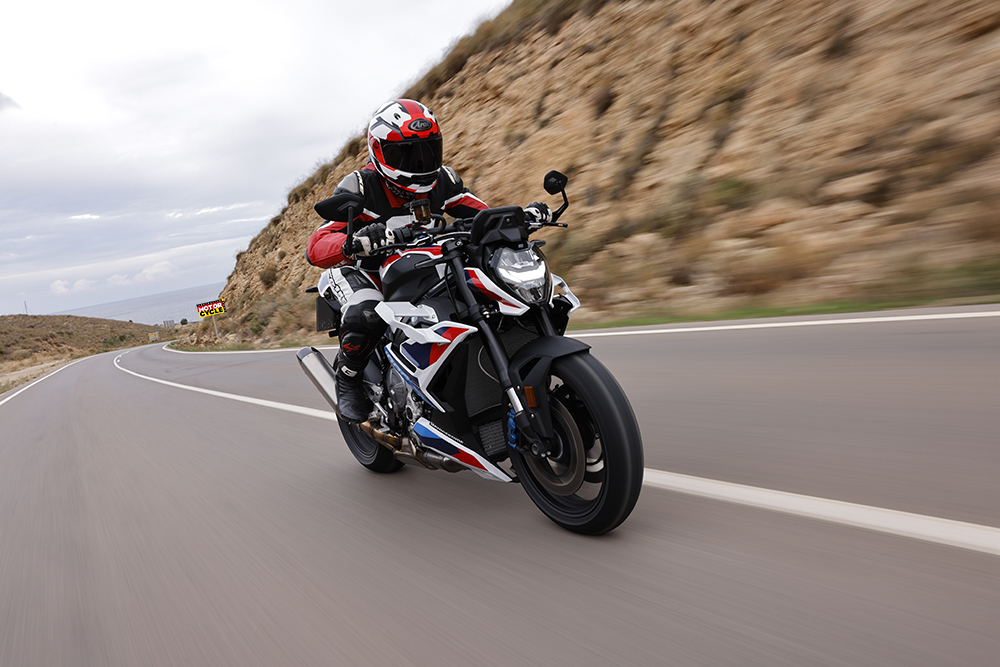
The BMW-developed M brake system is impressive and was purportedly developed through experience gained from the BMW Motorrad WorldSBK effort. The front brake consists of four-piston radial-mounted calipers gripping 320mm discs and it offers loads of stopping power and fantastic feel at the lever which, incidentally, is a beautiful and adjustable fold-up design – it looks and feels fantastic, as does the matching clutch lever.
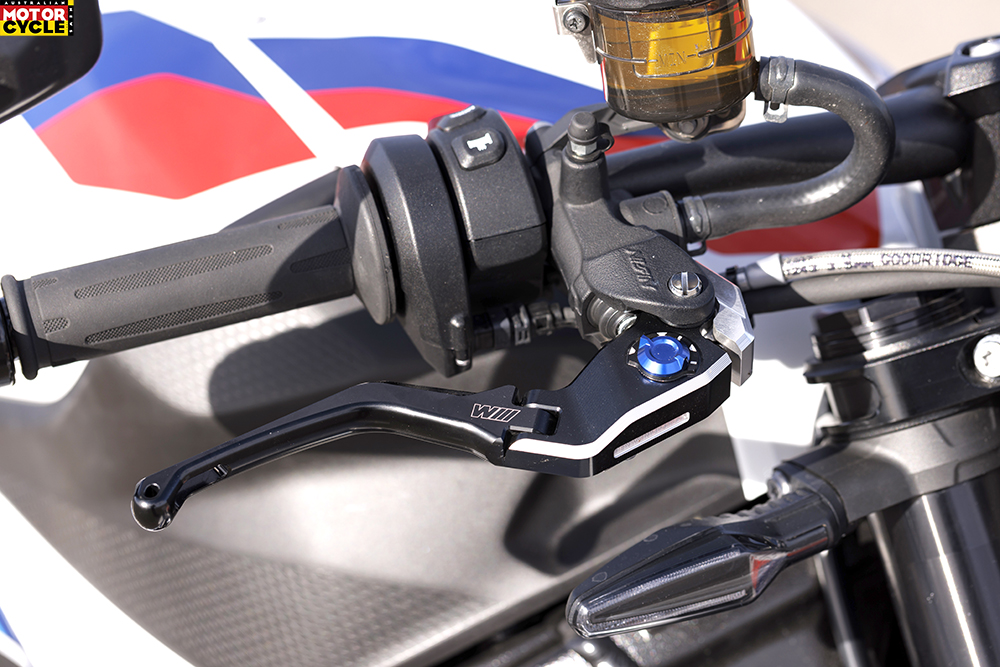
For clutchless gearshifts, the M 1000 R’s Shift Assistant Pro has got to be one of the best quickshifters on the market, allowing for fast and smooth gear changes both up and down the ratios and, unlike some other systems, it doesn’t balk when you want to shift with partial throttle openings. As well as the lower overall gearing compared with the S 1000 R, the M 1000 R has shorter fourth, fifth and sixth gear ratios, often negating the need for downshifting in tall gears when you want a sudden burst of acceleration; just open the throttle and it goes… hard. On the downside, the M 1000 R can feel a bit busy when cruising at highway speeds, and a bit buzzy. The vibrations aren’t too bad, but the inline four is certainly not as smooth as many V4s, or Yamaha’s crossplane-crank MT-10, for example.

Overall comfort is good, however, and after a long day in the saddle – on road and track – I felt fresh when I got off the M 1000 R. The seat is firm but well padded, and there’s plenty of room to move around. The 830mm seat height is getting up there, but it’s narrow where it needs to be making it easy enough to plant your feet on the ground. The controls (of which there are many) are positioned logically and take minimal familiarisation to master, including the click wheel on the left ’bar, which makes it easy to navigate through functions on the 6.5-inch TFT screen when on the move. The screen itself is bright, colourful and non-reflective, and is packed with accessible information, with all the important stuff (speed, tacho, mode and various electronic settings) presented in a clear and easy to read format. You can even see what your maximum lean angle is for each ride.

The cruise control is easy to use, and the heated grips were definitely appreciated on a chilly winter’s morning in Spain. There’s not a lot of weather protection on any nakedbike, but the
way in which the wind flows over you on the M 1000 R doesn’t cause undue helmet buffeting or discomfort. There’s a keyless ignition, but you’ll have to dig the key out of your pocket to open the small-ish 16.5L fuel tank.
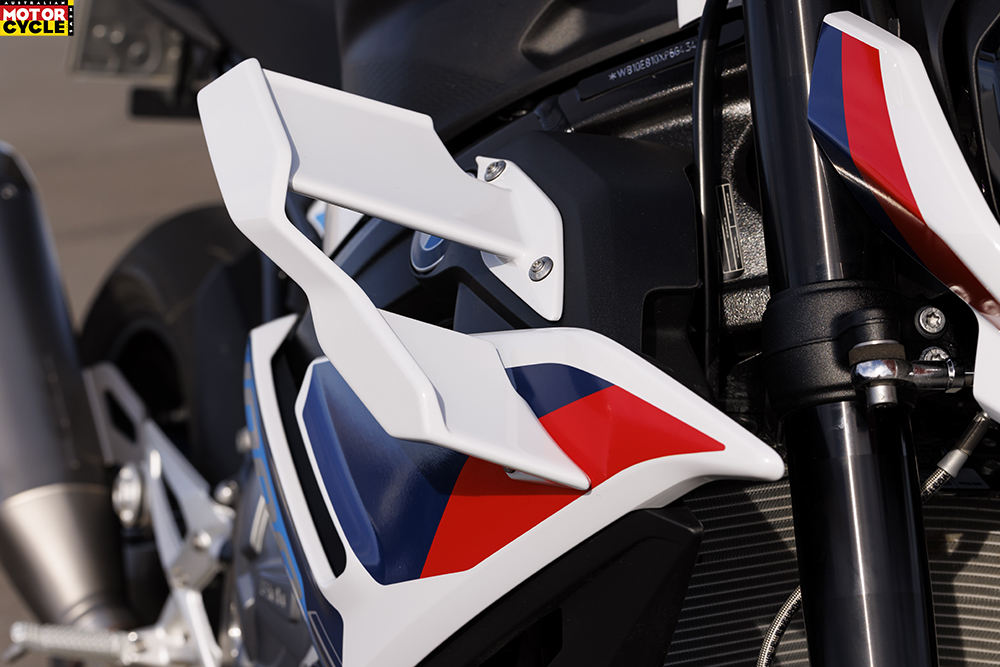
There are plenty of fabulous detail touches on the M 1000 R, such as the easily reversible gearshift pattern, those sweet brake and clutch levers, the tidy pillion seat cover, the embroidered M logo in the seat, the carbon-tipped Akrapovic muffler, the sculptured swingarm, the all-black fork, the blue anodised brake calipers, the quality plastics and so on. It might not have the flowing lines of some Italian exotics, and in a way those big wings almost look like tacked-on afterthoughts, but I still reckon the M 1000 R is a bike you could park in your garage and look at for hours.

Back when we last tested the BMW S 1000 R (AMCN Vol 71 No 22) Kel Buckley wondered if rather than sticking with that model’s 121kW inline four, whether at least a detuned version of the RR’s ShiftCam engine would have made better marketing sense. Well, in the M 1000 R, BMW has answered the call and delivered the full monty 154kW powerplant… and it’s been worth the wait.

Of course, there is a price to be paid for all that extra performance and those bespoke M bits and pieces; the M 1000 R will set you back $32,290 (ride away), which is $9K more than the S 1000 R, but even at that price it’s still the most affordable, high-tech 200hp-plus hyper-naked on the market.
